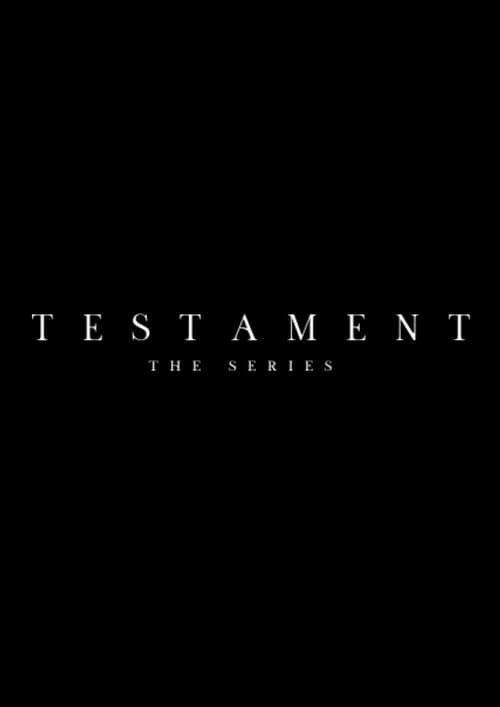
Ask Your Own Question
What is the plot?
The series Testament begins on Pentecost weekend in a modern alternate reality where the Roman Empire, called The Imperium, still rules, and The Temple functions like a contemporary Congress dominated by Sadducee and Pharisee parties. The opening scene shows Stephen at home with his mother Esther when the house starts to rumble and a strange booming sound comes from the sky. Stephen goes outside and witnesses the tail end of the Holy Spirit descending upon Jesus' followers gathered in an upper apartment, marking the beginning of the early church's spiritual awakening.
Following Pentecost, the story introduces Saul and Gamaliel, key figures who will play significant roles in the unfolding events. The Temple, led by High Minister Caiaphas, begins to react to the growing movement of Jesus' followers with suspicion and hostility. Temple guards, equipped like a modern SWAT team, start monitoring and persecuting those involved in the new faith.
Peter and John plan to preach on Temple grounds, but the Pharisees and Sadducees, wary of their influence, infiltrate the crowd with plants to provoke trouble. During the gathering, Peter heals a lame man named Caleb in the name of Jesus and proclaims the resurrection. Instead of acceptance, the planted agents accuse Peter of blasphemy, leading to the arrest of Peter, John, and Caleb.
Caleb's backstory is revealed: he struggles with drug addiction, adding complexity to his character and the challenges faced by the early believers. The disciples also engage in acts of charity, bringing food and water to the homeless, demonstrating their faith through service.
The Temple guards intensify their crackdown, arresting several accused of heresy. Roman Imperium soldiers patrol the streets of the District of Salem, enforcing curfews and threatening dissenters with advanced weaponry. Stephen is caught outside after curfew and threatened with a technologically advanced sword, highlighting the oppressive environment.
Amidst this tension, drunken men heckle the disciples, showing the social hostility they face. The narrative also includes flashbacks or retellings of Jesus' arrest and crucifixion, grounding the story in its biblical roots.
Throughout the series, the characters wrestle with their faith, internal conflicts, and the consequences of their decisions. The Temple's persecution escalates, but the believers continue to spread their message despite arrests and threats. The series emphasizes the joy and transformation experienced by the followers of Jesus, portraying their journey as a living story of faith in a hostile world.
The season ends with the community of believers growing stronger in their faith, even as external pressures mount, setting the stage for further developments in their mission and the inevitable martyrdom some will face.
What is the ending?
The ending of Testament (2025) shows the Followers facing a deadly ultimatum from Pilate and the Temple's purge of Salem. Amid chaos and battle, the Followers must choose between standing firm in faith or surrendering to fear. Mary confronts her deepest fears with the help of an unlikely ally. From this conflict, a powerful new beginning emerges.
In the final episode, titled Something New, the story unfolds as follows:
The episode opens with Pilate delivering a harsh ultimatum to the Followers: either they crush the movement or face the full wrath of the Imperium, the oppressive Roman regime still ruling the world. This ultimatum sparks immediate chaos, as the Temple seizes the opportunity to launch a purge of Salem, the city where the Followers have been gathering.
As the Temple's forces close in, the Followers are caught in a violent and uncontrollable battle. The tension is palpable, with the city descending into turmoil. The Followers, led by key figures such as Stephen and Mary, are forced to make a critical decision: abandon their hope and faith or stand against the storm despite overwhelming odds.
Mary, a central character, faces her deepest fears during this crisis. She must rely on an ally she does not fully trust, highlighting the desperation and complexity of the situation. This alliance is crucial for her survival and the survival of the movement.
Throughout the episode, the narrative shows the Followers risking everything to preach the good news of Jesus' resurrection, even as the Temple and Imperium seek to silence them. Public miracles and unburied secrets come to light, intensifying the conflict and forcing all characters to confront the true cost of their choices.
By the end of the episode, despite the chaos and losses, the Followers' decision to stand firm in faith leads to the birth of something powerful--a new beginning for the movement that promises hope beyond the immediate conflict.
Regarding the fate of main characters:
- Mary confronts her fears and survives with the help of an unlikely ally, symbolizing resilience and hope.
- Stephen and other Followers face the purge and battle but remain steadfast in their faith.
- Saul, who had been antagonistic toward the Followers, is not explicitly detailed in the finale's outcome but is implied to be part of the escalating conflict.
- The Temple and Pilate represent the oppressive forces whose purge brings destruction but ultimately cannot extinguish the movement's spirit.
This detailed scene-by-scene narrative highlights the climax of the series, focusing on faith, courage, and the birth of a transformative movement amid persecution and chaos.
Who dies?
Yes, characters do die in the TV show Testament (2025). Notably, the series includes the martyrdom of some characters as part of its narrative, which is a reimagining of the Book of Acts in an alternate-modern era. The show depicts followers of a resurrection who risk everything to preach the good news amid persecution by the Temple and the oppressive Imperium regime.
Specifically, the deaths of Ananias and Sapphira are highlighted in episode 4, described as "heart-wrenching." Their deaths are portrayed in the context of the early Christian community's struggles and the fallout from public miracles and faith experiences. The circumstances involve their deceit and subsequent divine judgment, consistent with the biblical account, which the show adapts dramatically.
Additionally, the series introduces characters such as Saul (Eben Figueiredo) and Gamaliel (Stewart Scudamore), who experience growth in faith, conversion, and martyrdom, indicating that their deaths are part of the storyline, though specific details of their deaths are not fully detailed in the available sources.
The show also references the death of Jesus, who is suspected of being the Messiah and is killed as a heretic by the Temple authorities. His crucifixion and resurrection are central to the plot, setting the stage for the subsequent events and character arcs.
In summary, the key character deaths in Testament include:
- Jesus: Killed by crucifixion as a heretic by the Temple, his resurrection sparks the movement.
- Ananias and Sapphira: Die in episode 4 due to their deceit, portrayed as a divine judgment.
- Saul and Gamaliel: Undergo martyrdom as part of their faith journey, though exact details are not fully described.
These deaths occur within the first several episodes, primarily between the initial episodes and episode 4, and are depicted as pivotal moments that drive the narrative of faith, persecution, and hope in the series.
Is there a post-credit scene?
The TV show Testament produced in 2025 does not have a post-credit scene. There is no information or indication from available sources that Testament includes any scenes after the credits. The filming wrap livestream and related coverage do not mention any post-credit content for this series.
In contrast, some other 2025 productions like Thunderbolts and Fantastic Four: First Steps do have post-credit scenes, but these are unrelated to Testament. Therefore, for Testament, you can leave after the credits without missing any additional scenes.
What specific miracles are publicly performed in Testament that influence the movement?
In Testament, public miracles play a crucial role in stirring the masses and fueling the movement sparked by the resurrection. These miracles are witnessed by many and serve as tangible signs that challenge the authority of the Temple and the oppressive Imperium regime, though the exact nature of each miracle is not detailed in the available summaries.
How does the character Saul of Tarsus evolve throughout the series?
Saul of Tarsus is a central character whose journey reflects a significant transformation. Initially aligned with the Temple's efforts to suppress the followers of the risen Messiah, Saul's experiences and encounters with the movement lead to fractured loyalties and a personal reckoning, highlighting his complex role in the unfolding events.
What are the key secrets that are buried and later revealed in the storyline?
The series Testament features buried secrets that surface as the story progresses, impacting both the followers and their opponents. These secrets contribute to the tension and conflict between the Temple and the movement, forcing characters to confront difficult truths, though specific secrets are not explicitly described in the available information.
How does the Temple attempt to silence the followers, and who are the main figures involved?
The Temple actively works to silence the followers of the risen Messiah to prevent the spread of their message and avoid retaliation from the Imperium regime. This involves political and possibly violent measures, with key figures such as Gamaliel and John Zebedee playing roles in the Temple's efforts to maintain control and suppress the movement.
What role does Mary Magdalene play in the series Testament?
Mary Magdalene is portrayed as one of the followers of the risen Messiah who is deeply involved in spreading the good news. Her character is integral to the movement's efforts and embodies the hope and risk undertaken by the followers in the face of oppression by the Temple and the Imperium.
Is this family friendly?
The TV show Testament (2025) is a live-action reimagining of the Book of Acts set in a modern dystopian era, focusing on the early followers of Jesus and their struggles under an oppressive regime. It is not specifically designed as family-friendly content for young children or very sensitive viewers.
Potentially objectionable or upsetting aspects include:
-
Depictions of persecution and violence: The series involves the apostles and followers facing severe opposition, including historically accurate and potentially disturbing deaths such as stoning and executions for their faith.
-
Themes of oppression and turmoil: The setting is a dystopian world with an oppressive regime, which may include tense, dark, or intense scenes reflecting conflict and danger.
-
Religious and spiritual intensity: The show deals deeply with faith, miracles, and moral struggles, which might be intense or challenging for some viewers, especially children or those sensitive to religious themes.
No explicit spoilers are revealed here, but parents or sensitive viewers should be aware that the series contains mature themes of violence, persecution, and intense emotional and spiritual conflict, making it more suitable for older teens and adults rather than young children.






















